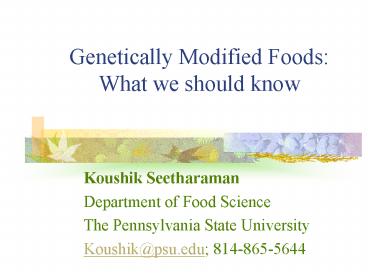Genetically Modified Foods: What we should know - PowerPoint PPT Presentation
1 / 20
Title:
Genetically Modified Foods: What we should know
Description:
Genetically Modified Foods: What we should know. Koushik Seetharaman. Department of Food Science. The Pennsylvania State University. Koushik_at_psu.edu; 814-865-5644 ... – PowerPoint PPT presentation
Number of Views:101
Avg rating:3.0/5.0
Title: Genetically Modified Foods: What we should know
1
Genetically Modified FoodsWhat we should know
- Koushik Seetharaman
- Department of Food Science
- The Pennsylvania State University
- Koushik_at_psu.edu 814-865-5644
2
Prelude
- Past experiences
- Research at Iowa State University
- Consultant in food industry
- PhD from Texas AM University
3
Research Focus
- Cereal grains
- Grain quality
- Cereal-based ingredients
- Processing of cereal-based foods
4
Extension Focus
- Work with cereal-based industry in PA
- Baking companies
- Pretzel companies
- Ingredient manufacturing companies
- Develop information materials and courses for the
cereal-based industry as needed - Translate research into applications to assist
the industry as needed
5
Cereal-Based Processing Industry in PA (1992)
- 3rd largest processing state
- 2nd largest in potato chips and salty snacks
- 3rd largest in breads, rolls and cakes
- 3rd largest in cookies and crackers
- 4th largest in pasta and noodle production
- Many small and medium-sized companies
6
Genetically Modified Organisms/ Foods
- What is it?
- How are they created?
- Prevalence
- Benefits
- Issues
7
Definitions
- Any food that has been made from genetically
altered plants or animals - Genetic alteration Altering gene/s using
recombinant technique - Gene Small segment of DNA that codes for a
specific protein - Recombinant technique (rDNA) Methods used to
alter gene/s
8
How are GMOs created
- Identify a beneficial gene
- Cut it out from the DNA
- Insert it in-vitro into DNA of another organism
(Agrobacterium) - Insert altered DNA in-vivo into the receiving
organism (plant) using one of many techniques - Hope it works!
9
Agrobacterium A Common Technique
- A bacterium in nature that invades plants,
transfers its DNA into the plant to produce food
for its survival - This feature is used by geneticists
- Creation nonpathogenic strains of Agrobacterium
- Insert gene of interest into this strain of
bacterium and let it work its charm!
10
DOMESTICATION OF MODERN DAY CROPS
TEOSINTE TO MAIZE
11
Is Genetic Engineering Different from Traditional
Breeding?
- Yes!
- Specific gene/s from any source can be
introduced and is faster - No!
- Traditional breeding also involves gene transfer
but thousands of genes, good and bad, are moved
12
GMO Prevalence in Agriculture (Acreage in 2000)
- 25 of corn, USA
- 54 of soybean, USA
- 61 of cotton, USA
- 70 of canola (rapeseed), Canada
- 90 of soybeans, Argentina
- 10-30 of soybeans, Brazil
13
Prevalence in Foods
- Source ingredients produced from genetically
altered crops - Oil and proteins from soy
- Starch and oil from corn
- Tomato paste products
- 60 of foods purchased from supermarket have
ingredients from genetically altered crops
14
Benefits
- Input traits
- Targeted control of pests, weeds and pathogens
- Reduced use of chemicals in agriculture
- Increased yields
- Ability to utilize saline or arid lands for
agriculture
15
Input Trait Modified Crops
16
Benefits
- Output traits
- Improved quality of proteins, starch, oils
- Reduction or elimination of allergens and toxins
- Carrier for edible vaccines
- Increased absorption of essential nutrients
- Improve shelf life and quality of fruits and
vegetables
17
Output Trait Modified Crops
18
Issues
- Ethical
- Playing God?
- Environmental
- Genetic drift and impact on ecosystem
- Safety
- Allergens, toxins, antibiotic resistance
development - Proprietary nature of technology
19
Conclusion
- Possibilities are endless using this technology
- Issues exist and need to be addressed
- Further research to continue to address consumer
concerns - Knowledge is important to have an informed
discussion
20
Some Links
- http//www.usda.gov/agencies/biotech/index.html
- http//www.ift.org/resource/policy/biotechreport.s
html - http//www.scisoc.org/aacc/MEETING/Biotechsymposiu
m00 - http//www.foe.co.uk/campaigns/food_and_biotechnol
ogy/gm_food/ - http//www.greenpeace.org.uk/contentlookup.cfm?Sit
eKeyParamGMFoods1































